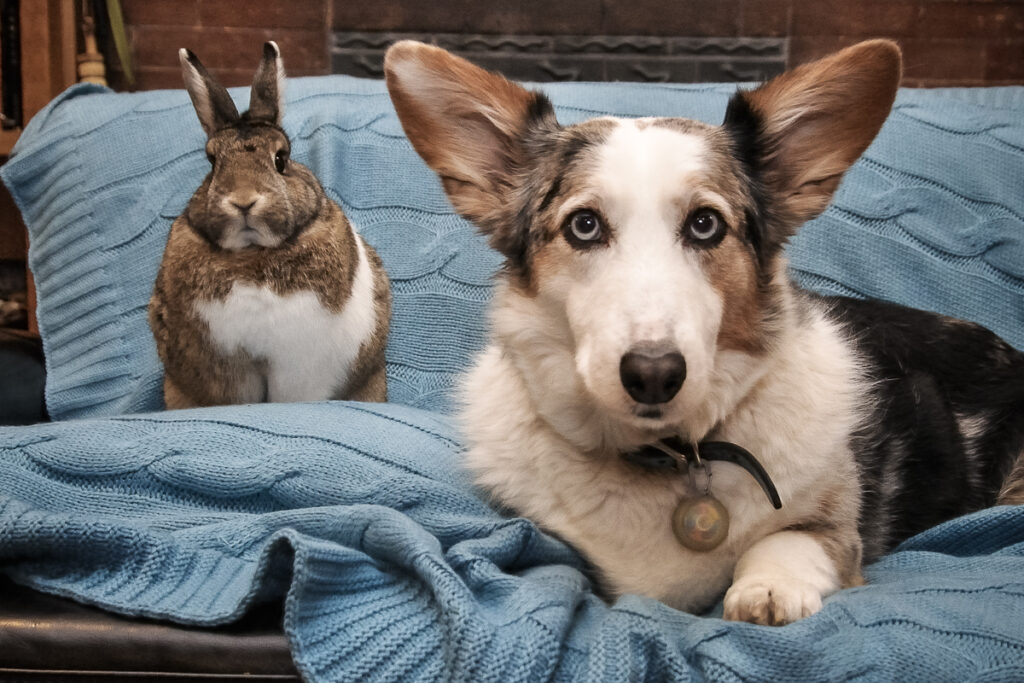Those of us who share our lives with non-human animals know the joy these friendships bring us. To create a home where several species live together peaceably is to set up a mini-utopia where humans respect rather than exploit the other inhabitants. It’s also a lot of fun.
In previous [articles] we have described friendships between rabbits and cats. We now approach the rabbit-canine interface, with equal measures of optimism and caution.
FAMILIARITY BREEDS CONTENTMENT
These guidelines are designed to allow Thumper and Fido to get accustomed to each other in a safe, positive environment. Because each situation is determined by the individual personalities involved, no single “right way” exists. As a general rule, it is better to go too slowly and succeed than to rush things and risk disaster. Most rabbits feel more confident in the safe haven of their familiar territory[with the dog caged.] A rabbit who would run from a dog if [the dog] were uncaged will often come right up and stiff through the cage.
Encourage and praise all gentle, investigative behavior: “good dog, that’s gentle, what a good gentle dog you are.” Fido is learning to associate the word “gentle” with quiet, friendly interest, and he is getting praised for it. You can use the word “gentle” later on, as a reminder to him if he starts to get rowdy. You are teaching him “yes,” which is a much more important learning tool than “no.”
What if Fido Gets Excited?
If the dog becomes too excited, tell him “off” or “no” and give a quick tug-and-release on the leash. If he calms down, praise him. If you have to correct him constantly, you’re going too fast. He may feel that the rabbit is nothing but a source of frustration and reprimands. This dog needs some obedience training before he’s ready to meet Thumper. “Down-stay,” “gentle,” “good dog,” and “off” should become integral parts of his vocabulary. Your ultimate goal may be for Fido to lie down and stay, even with Thumper running freely about the room. Think of this as a Ph.D. in down-stay. Work toward it gradually, in steps that challenge Fido but that are not impossible. Set him up to succeed.
What If Fido is a Mellow Dog?
A confident rabbit and a mellow dog may be able to meet nose to nose, with no cage between them. Put Fido on-leash and in a down-stay. Have Thumper brought into the room. Allow her to check out this strange new being. Again, praise Fido’s calm behavior.
Repeat these encounters daily. The early stages of strict control can last days or weeks or months. The animals involved will set the pace. Your job is to pay close attention and to be absolutely sure that everyone (dog, human, and rabbit) is ready before moving on to the next level of freedom. A first step in easing your supervision of the proceedings could be to remove the leash. Or you could leave the leash on but release Fido from the down-stay. Or you could switch to a sit-stay, so Thumper can get used to Fido in a new position.
OBEDIENCE TRAINING: WHY?
Training is communication. It is a way of showing the dog that the noises that come out of your mouth have some meaning for the dog. A dog who has received gentle, positive, effective obedience training knows to look to his human for guidance when he’s in a new or unfamiliar situation. A dog who goes bonkers and completely ignores you whenever the slightest distraction presents itself is not a good candidate for rabbit-friend. Training should build the bond of trust and respect between you and Fido.
THE FAMILY FACTOR
But aren’t rabbits and dogs natural enemies? Can we ever overcome the dog’s instinct for predation?
Well, yes. And no. It depends on the dog. And the rabbit. And the human. Speaking of humans, and natural enemies, what species tortures and kills millions of rabbit every year in the name of fashion? What species domesticated, breeds, and trains dogs to kill rabbits not for sustenance but for “sport”? If you were a rabbit, which species would you be wary of?
In many dogs, the hunting instinct is buried deep below generations of domestication. Others have a stronger urge to chase, which may even have been encouraged (or, at least, not effectively discouraged) by their human. The purpose of the introductory exercises is not only to control Fido and to teach him your definition of good manners but also to show him that Thumper is a member of your (and his) household. Just as a dog might chase neighborhood cats but not cats with whom he lives, Fido can learn that Thumper is family, not dinner. Of course, these possibilities do not exist for hutch rabbits or back-yard dogs. Such animals are not members of your or each other’s family and should never be left alone together.
Can you ever leave Fido and Thumper together without supervision?
The cautious approach says no. For some situations, this is also the realistic answer. I have heard many horror stories about dogs and rabbits who were “just fine together until one day… I don’t know how it could have happened….” In all of these cases the definition of “just fine together” was very different from the one proposed here. It does not mean “Fido doesn’t lunge at the cage every time he walks by it, but they’ve never actually been together with Thumper out of his cage.” Nor does it mean “But Fido’s such a sweet dog. He’s great with the kids” or “I yell at him every time he goes for the rabbit . He knows he’s not supposed to.”
I wish I could give a specific description of what it does mean. The best I can offer is that it’s a feeling. If you’re not sure, don’t do it. If you do want to try it, at first leave them together for short periods when you are home. Be honest with yourself. If Fido and Thumper can keep company with you, that’s an admirable goal and a source of pleasure for everyone.
Further Reading:
- Bunnies and Dogs: An Introduction
- Dog Training: A Guide to Commands and Skills for Living with a House Rabbit
- Rabbits Living With Other Pets (Rabbit Welfare Association & Fund) https://rabbitwelfare.co.uk/rabbits-living-with-other-pets/
- Animal Welfare Association PDF https://awanj.org/wp-content/uploads/Rabbit-Handout-08-Dogs-and-Rabbits-Introduction.pdf
- Dog Meets Bunny Blog http://dogmeetsbunny.blogspot.com/

